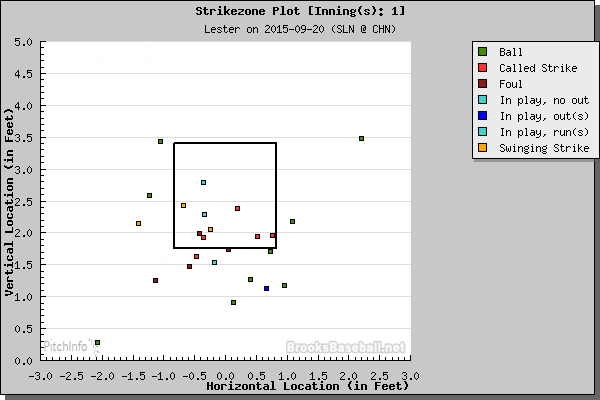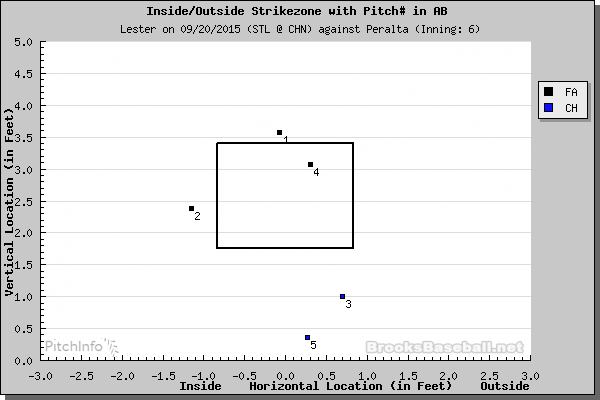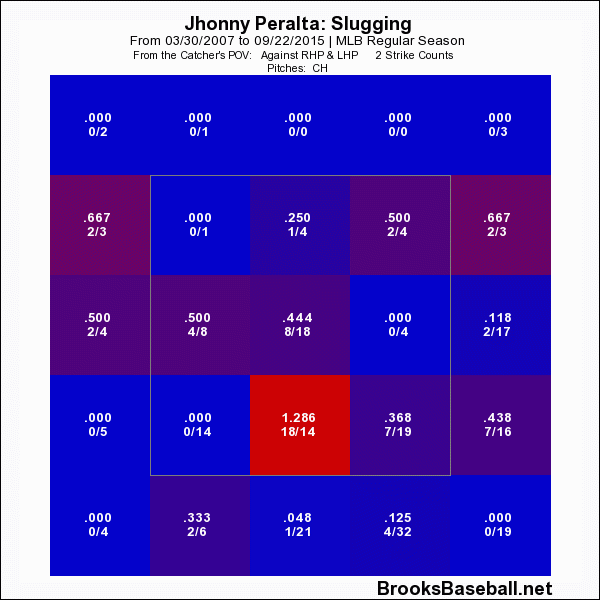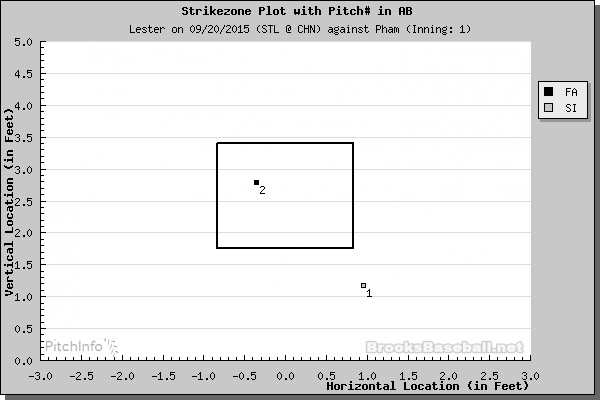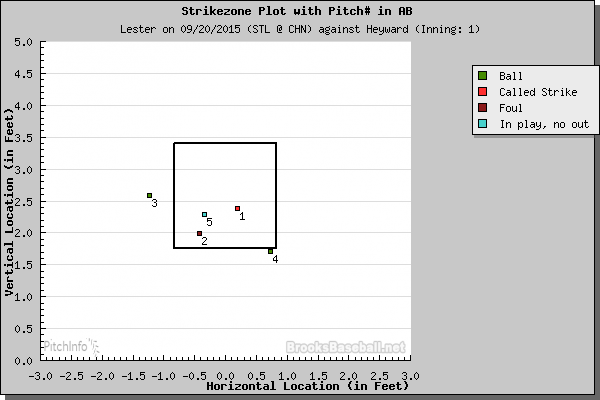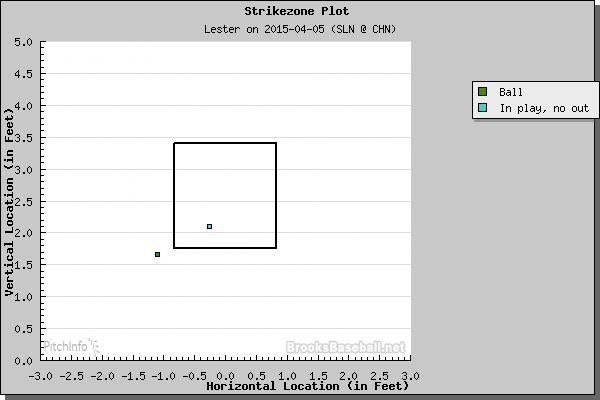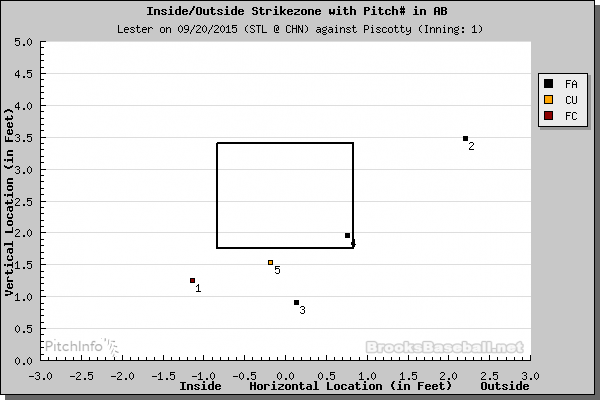Date: September 20, 2015
Opponent: St. Louis Cardinals
Location: Wrigley Field
Introduction
Chris Rock followed Bigger & Blacker with Down to Earth. The Office followed its first six seasons with its final three seasons. Pearl Jam followed the 1990s with the first half of the 2000s.
This is a convoluted, perhaps unnecessarily snarky way of saying that brilliant efforts are followed occasionally by a less than brilliant effort. Be it a beloved comic, sitcom, band, or front of the rotation starter, those at the top of their profession are not immune from a professional speed bump. Such was the case with Jon Lester’s Sunday afternoon start against the St. Louis Cardinals.
In Lester’s first three September starts, he had allowed 16 baserunners in 21 innings pitched (0.762 WHIP) and held batters to a .451 OPS. Just a scant five days earlier, Lester had put together his best performance of the season.
On Sunday, it got ugly early, but then it was somewhat okay from there. In fact, despite the disappointing start, there is no reason to believe Lester will not be ready for the Cardinals come October (see Keep-In-Mind section).
Lester threw at least 23 pitches in three of six innings, after not having a single 20-pitch inning three of his last four starts. He had not allowed a first-inning run at home since July 11th, a span of eight starts. He issued three walks for just the fifth time this season. He was missing too many spots with his fastballs, including two of three hits he surrendered in the first inning (see Key At-Bat/Sequence section). In that decisive first inning, Cardinals hitters were patient, mostly laying off pitches that were out of the zone or low in the zone, and waiting for Lester to come up with the fastballs:
There was some good. Lester’s cutter has been his best pitch in September, and he used it to pick up three of his seven strikeouts (see Pitch Breakdown section). The changeup also continues to emerge as an effective pitch late in the season. Thanks in large part to those two pitches, Lester struck out at least seven batters for the third consecutive game, the first time he’s done that since before the All-Star break. And despite constant traffic on the basepaths, Lester used a timely pickoff and some key punch-outs to limit damage and keep the Cubs in the game.
While the Cardinals entered the game with a few hot hitters (Tommy Pham, 9-for-20, three home runs in previous six games), the team had been struggling slightly offensively (36 runs scored in their previous 10 games). The Cardinals had been devoid of power since the All-Star break, ranking in the bottom five in the NL in doubles, home runs, home run to flyball ratio, and slugging percentage (they rank sixth to last in ISO). Throw in the team’s numbers against left-handed pitchers (.231/.310/.353) and Lester’s previous three starts against St. Louis (0.857 WHIP and 0.86 ERA), and on paper, it was a start that favored Lester.
However, the game is not played on paper, as a crusty, middle-aged newspaper person might say. Mediocre starts will happen. So, crank up Pearl Jam’s Yield and read below to see how this one was rough from the jump.
Traditional Line
6.0 IP, 6 H, 7 K, 3 BB, 4 ER
Pitch Breakdown
110 pitches (67 strikes)
| Total | Velocity (Max) | AVG | SLG | BABIP | |
| Four-Seam | 53 | 92.9 (95.1) | .500 | 1.500 | .500 |
| Cutter | 25 | 87.7 (90.1) | .250 | .250 | .400 |
| Sinker | 8 | 92.6 (93.6) | .333 | .333 | .333 |
| Change-Up | 9 | 85.7 (87.0) | .000 | .000 | .000 |
| Curveball | 15 | 76.2 (79.0) | .333 | 1.333 | .000 |
Lester has thrown at least 50 four-seam fastballs in three consecutive starts for the first time since April of 2014. During this stretch, batters are slugging .393 and he has not surrendered a hit with two strikes, despite throwing the pitch 35.3 percent of the time with two strikes. On Sunday, he induced just three whiffs and one strikeout. His velocity was down nearly a full mile per hour from his previous start against the Cardinals, from just under 94 mph to just under 93 mph. However, Pham’s first-inning home run was not a case of velocity, but rather a missed spot (see Key At-Bat/Sequence section).
Lester’s changeup and curve were effective, save for Stephen Piscotty’s home run, of course (see Key At-Bat/Sequence section). On the day, he got a combined five whiffs on 13 swings, and picked up three of his seven strikeouts. As we will detail below, a curveball was the right pitch selection against Piscotty, but the execution was poor. In his last three starts, Lester has gone to his change with increased frequency (about eight percent of all pitches, four percentage points above his season average), and it has been effective (no baserunners and two strikeouts). On Sunday, he used his four-seamer to set up the change, similar to the way he has used the four-seamer to set up the curve this season. Against Jhonny Peralta in the seventh inning, after two four-seamers way up in the zone, Lester and David Ross came back with a changeup in the dirt:
Peralta whiffed for strike three. The execution was excellent, but so was Ross’ pitch selection. In his career against changeups from left-handed pitchers, Peralta owns a 21.6 percent strikeout rate and .398 slugging percentage. And as you can see below, when pitchers get two strikes on Peralta, he has done little with changesups down:
The strikeout served to illustrate:
2.) When Lester executes Ross’ gameplan, good things happen
3.) With the playoffs two weeks away, Lester is rolling with four viable strikeout pitches
Lester’s cutter has quietly been his best pitch in September. In four starts, he has thrown it 23.74 percent of all pitches (about three percentage points below his season average), but nearly 40 percent of his strikeouts (10 of 26) have come off the cutter, above his season average of 32 percent. Batters are slugging .290 against the cutter, and just .234 with two strikes. On Sunday, he used it to pick up three strikeouts, and 21 of 25 cutters went for strikes, with aggressive St. Louis hitters swinging at 18 of 25 cutters. The pitch that had been a mess in the season’s first half (.444 slugging percentage and 14 extra-base hits) has become a dependable number-two pitch. In the second half, opposing batters are slugging .322, and Lester has gone to it more than any other pitch with two strikes (34.2 percent) and picked up more strikeouts (29) than he has with any other pitch.
Trends
You just read through a longer than usual Pitch Breakdown section, so I will keep the Trends section mercifully brief. It’s really just a follow-up to last week’s section. You might recall less than a week ago, following Lester’s best start of 2015, I used Trends to discuss Lester’s recent scarcity of home runs surrendered. As we wrote then, Balladeers:
Remember when Lester surrendered eight home runs in six starts off only cutters and four-seamers? Or less than a month ago when he surrendered three home runs (one each off his four-seamer, sinker, and cutter) at home at home against the Tigers?
We continued:
In Lester’s five starts since that disaster against Detroit, he has not surrendered a home run, and just six extra-base hits. Lester has held batters to just a .262 slugging percentage, with a .253 slugging percentage against his fastballs (four-seamer, sinker, and cutter).
We finished with:
What is happening is batters aren’t doing anything with fastballs when he leaves them over up in the zone.
Two batters into the game, or just two batters following those rambling words above, Lester left a fastball up in the zone and Pham hit it out of the park. When you leave a 93-mph fastball up in the zone, you are living dangerously.
Key At-Bat/Sequence
Inning: First Inning
Score: 0-0
Situation: Start of game
Batter(s): Tommy Pham, Jason Heyward, and Stephen Piscotty
Entering Sunday, Lester had not surrendered a first-inning home run in 2015. That changed quickly.
After getting Matt Carpenter to strikeout on a 94-mph four-seamer, Lester faced Pham. He started Pham with a 93.7-mph sinker low and away. Behind 1-0, Lester attempted to go low and away again, this time with a 93.1-mph four-seamer:
As we detailed above in the Trends section, the pitch stayed up in the zone and Pham hit his first home run off a four-seamer in 2015. Lester had been hitting his spots consistently with his four-seamer over the previous month, but it changed just seven pitches into the game.
With a run in and one out, Jason Heyward stepped to the plate, hitting .268/.341/.346 against left-handers this season. Entering the game, Heyward was slugging .308 against cutters from left-handed pitchers, and just .143 with two-strikes. On a 2-2 count, Lester attempted to put him away with a 90.6-mph cutter.
The pitch, though, stayed over the plate. On Opening Night, Lester attempted the same pitch to Heyward, the second batter of the season, this time in a 1-0 count:
Heyward would pull the 91-mph flat cutter for a double, and eventually come around to score the game-winning run. Perhaps going forward, Lester and Ross should refrain from cutters against Heyward.
Piscotty entered the game struggling in September, hitting just .250/.324/.313 with no home runs. During that stretch, he was slugging .238 against four-seamers and cutters, which is likely why Lester and Ross went with them exclusively on the first four pitches. On 2-2, after evening the count with a 93-mph four-seamer on the outside corner, Lester attempted to come down and in with a curve:
The pitch, though, stayed up and in the middle of the zone, and Piscotty’s home run would give the Cardinals a 3-0 lead. It was a solid idea, as Piscotty was slugging .231 against breaking pitches from left-handers.
If there is a positive take away from the first inning, it’s that Lester and Ross had a good game plan, but Lester’s execution was just not sharp.
Keep-In-Mind
Lester’s regular season against the Cardinals was bookended by subpar performances, including his first start of the season. However, if (or when) the Cubs and Cardinals meet in October, his overall season performance against St. Louis should inspire confidence in the potential matchup:
| Starts | Avg. Start | Avg. Game Score | WHIP | ERA | K% | BB% | BABIP |
| 5 | 6.27 IP | 59 | 1.117 | 2.59 | 26.8% | 7.9% | .275 |
Additionally, his fourth and fifth best performances (by Game Score) have come against the Cardinals.
Lester’s pitch selection has mostly been in line with his season averages. He has been slightly more four-seam and cutter heavy, going to the two pitches a combined 75.3 percent of the time, about six percentage points above his season average. Cardinals batters have hit one home run each off his four-seamer, cutter, and curve. When Lester has kept his fastballs down and mixed in his curve, he has had considerable success against the Cardinals. Do not be shocked if that continues into autumn.
Conclusion
The first inning, ultimately, would prove to be too much to overcome for Lester and the Cubs. Missed locations with his “big three” pitches—four-seam, cut, and curve—would lead to three hits and three Cardinals runs. Lester would limit damage the rest of the way, but the team could not come all the way back. After a transcendent two-start stretch at St. Louis and Pittsburgh, a less-than-brilliant start is understandable. Right now, all five of his pitches are effective, both early and late in counts, and even a subpar performance against the Cardinals kept the Cubs in the game. For Lester and his outstanding second-half numbers (2.87 FIP and 1.04 WHIP), it’s simply on to the next one. It was not a great start, but it was not “Nard Dog as Scranton Branch Manager” bad.
Season to Date
10-11, 3.46 ERA (3.81 DRA), 1.168 WHIP, 24.7% K, 6.1% BB
Next Start
Saturday, September 26th vs. Pittsburgh Pirates
Lead photo courtesy of Matt Marton-USA TODAY Sports

